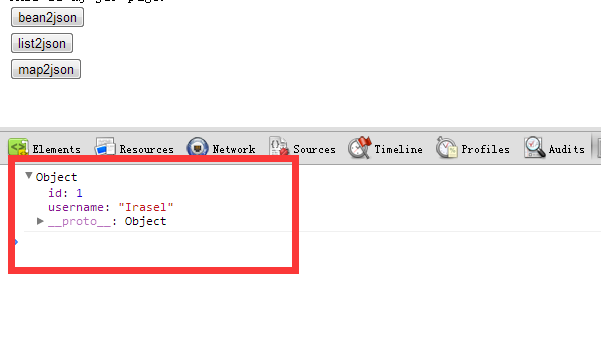一.返回ModelAndView,其中包含map集
/*
* 返回ModelAndView类型的结果
* 检查用户名的合法性,如果用户已经存在,返回false,否则返回true(返回json数据,格式为{"valid",true})
*/
@RequestMapping(value = "/checkNameExistsMethod2", produces = "application/json;charset=UTF-8") //这里的produces值在不设置的情况下将根据返回结果自动决定
public @ResponseBody
ModelAndView checkNameValidMethod2(@RequestParam String name) {
boolean result = true;
//...
Map<String, Boolean> map = new HashMap<>();
map.put("valid", result);
return new ModelAndView(new MappingJackson2JsonView(), map);
}
方式一:使用jackson-databind-x.x.x.jar包中的ObjectMapper将Map型数据改写为String并返回
/*
* 返回String类型的结果
* 检查用户名的合法性,如果用户已经存在,返回false,否则返回true(返回json数据,格式为{"valid",true})
*/
@RequestMapping(value = "/checkNameExistsMethod1", produces = "application/json;charset=UTF-8")
public @ResponseBody
String checkNameValidMethod1(@RequestParam String name) {
boolean result = true;
//...
Map<String, Boolean> map = new HashMap<>();
map.put("valid", result);
ObjectMapper mapper = new ObjectMapper();
String resultString = "";
try {
resultString = mapper.writeValueAsString(map);
} catch (JsonProcessingException e) {
e.printStackTrace();
}
return resultString;
}
方式二:
直接返回字符串,主要key/value值必须使用含有转义字符\的双引号,单引号无效
/*
* 返回String类型的结果
* 检查用户名的合法性,如果用户已经存在,返回false,否则返回true(返回json数据,格式为{"valid",true})
*/
@RequestMapping(value = "/checkNameExistsMethod1", produces = "application/json;charset=UTF-8")
public @ResponseBody
String checkNameValidMethod1(@RequestParam String name) {
boolean result = true;
String resultString = "{\"result\":true}"; //注意一定是双引号 "{\"result\":\"success\"}"
return resultString;
}
三.返回任何预定义class类型的结果:
@RequestMapping(value = "/findEmployeebyName")
public @ResponseBody
Employee findEmployeebyName(String name) {
List<Employee> lstEmployees = employeeService.getAllEmployees();
for (Employee employee : lstEmployees) {
if (employee.getName().equals(name))
return employee;
}
return null;
}
这里的Employ必须事先定义好。
四.使用HttpServletResponse对象的response.getWriter().write(xxx)方法
@RequestMapping(value="/forbiddenUser")
public void forbiddenUser(int id,HttpServletRequest request,HttpServletResponse response) {
String resultString="{\"result\":\"success\"}";//注意一定是双引号 "{\"result\":true}"
try {
response.setContentType("application/json");
response.getWriter().write(resultString);
} catch (IOException e) {
e.printStackTrace();
}
}
spring4mvc返回json(bean,list,map)
因为spring3和spring4的mvc在前端返回json所需要的jar包不一样,所以索性写一篇关于spring4mvc在前端返回json的博文。
首先,新建一个web项目,项目格式如图所示:

convertJsonAction:springmvc的action类
inde.jsp:有三个按钮,分别返回bean,list和map对应的json
然后是引入的library:分别是spring-core,spring-mvc,spring-web,servlet> <servlet-name>DispatcherServlet</servlet-name> <servlet-class>org.springframework.web.servlet.DispatcherServlet</servlet-class> <init-param> <param-name>contextConfigLocation</param-name> <!-- 将配置对应的springmvc文件设置在src根目录下 --> <param-value>classpath:springmvc.xml</param-value> </init-param> </servlet> <servlet-mapping> <servlet-name>DispatcherServlet</servlet-name> <url-pattern>*.action</url-pattern> </servlet-mapping>
然后在src下面新建一个叫springmvc的xml文件,文件内容如图所示:
<?xml version="1.0" encoding="UTF-8"?>
<beans xmlns="http://www.springframework.org/schema/beans"
xmlns:mvc="http://www.springframework.org/schema/mvc" xmlns:xsi="http://www.w3.org/2001/XMLSchema-instance"
xmlns:context="http://www.springframework.org/schema/context"
xsi:schemaLocation="
http://www.springframework.org/schema/beans
http://www.springframework.org/schema/beans/spring-beans.xsd
http://www.springframework.org/schema/mvc
http://www.springframework.org/schema/mvc/spring-mvc.xsd
http://www.springframework.org/schema/context
http://www.springframework.org/schema/context/spring-context.xsd
">
</beans>
接着我们在ConvertJSonAction.java类中添加一个方法:
package com.mz.json;
import org.springframework.stereotype.Controller;
import org.springframework.web.bind.annotation.RequestMapping;
import org.springframework.web.bind.annotation.ResponseBody;
/**
* controller指明这是一个springmvc的action类
* requestMapping是总的路径,所有访问这个action类中的方法必须通过/convert
* @author asus
*
*/
@Controller
@RequestMapping("/convert")
public class ConvertJsonAction {
//responseBody是指返回的User是一个json对象(也可以是string或者xml对象)
@RequestMapping("/bean2json")
public @ResponseBody User bean2json() {
User user = new User();
user.setId(1);
user.setUsername("Irasel");
return user;
}
}
这是action的处理类,接着我们在springmvc中配置开启mvc的annotation和扫描标签:
<mvc:annotation-driven />
<context:component-scan base-package="com.mz.json"></context:component-scan>
index.jsp中添加三个按钮,每一个按钮分别对应的返回一个bean对象的json,list对象的json和map对象的json:
<!-- 点击返回一个bean对象的json -->
<input type="button" value="bean2json"><br/>
<!-- 点击返回一个list对象的json -->
<input type="button" value="list2json"> <br/>
<!-- 点击返回一个map对象的json -->
<input type="button" value="map2json"><br/>
使用jquery的异步传输:
$(':button:first').click(function(){
var url = 'convert/bean2json.action';
var arg =null;
$.post(url,arg,function(returnData){
console.log(returnData);
});
});
效果如图所示:

接着是list和map的方法(不再粘贴效果图了,反正都差不多)
@RequestMapping("/list2json")
public @ResponseBody List<User> list2Json() {
List<User> users = new ArrayList<User>();
User user1 = new User();
user1.setId(1);
user1.setUsername("Irasel");
User user2 = new User();
user2.setId(2);
user2.setUsername("路西法");
User user3 = new User();
user3.setId(3);
user3.setUsername("Micheal");
users.add(user1);
users.add(user2);
users.add(user3);
return users;
}
@RequestMapping("/map2json")
public @ResponseBody Map<String, Object> map2Json() {
List<User> users = new ArrayList<User>();
Map<String, Object> map = new HashMap<String, Object>();
User user1 = new User();
user1.setId(1);
user1.setUsername("Irasel");
User user2 = new User();
user2.setId(2);
user2.setUsername("路西法");
User user3 = new User();
user3.setId(3);
user3.setUsername("Micheal");
users.add(user1);
users.add(user2);
users.add(user3);
map.put("row", users.size());
map.put("users", users);
return map;
}
SpringMVC通过实体类返回json格式的字符串,并在前端显示
一.除了搭建springmvc框架需要的jar包外,还需要这两个jar包
jackson-core-asl-1.9.2.jar和jackson-mapper-asl-1.9.2.jar
二.web,.xml配置
|
1
|
classpath:spring-servlet.xml指定springmvc配置文件的位置 |
|
1
2
3
4
5
6
7
8
9
10
11
12
13
14
15
16
17
18
19
20
21
22
23
24
25
26
27
28
29
|
<?xml version="1.0" encoding="UTF-8"?><web-app version="2.5" xmlns="http://java.sun.com/xml/ns/javaee" xmlns:xsi="http://www.w3.org/2001/XMLSchema-instance" xsi:schemaLocation="http://java.sun.com/xml/ns/javaee http://java.sun.com/xml/ns/javaee/web-app_2_5.xsd"> <servlet> <servlet-name>spring</servlet-name> <servlet-class>org.springframework.web.servlet.DispatcherServlet</servlet-class> <init-param> <param-name>contextConfigLocation</param-name> <param-value>classpath:spring-servlet.xml</param-value> </init-param> <!-- 可以自定义servlet.xml配置文件的位置和名称,默认为WEB-INF目录下,名称为[<servlet-name>]-servlet.xml,如spring-servlet.xml <init-param> <param-name>contextConfigLocation</param-name> <param-value>/WEB-INF/spring-servlet.xml</param-value> 默认 </init-param> --> <load-on-startup>1</load-on-startup></servlet> <servlet-mapping> <servlet-name>spring</servlet-name> <url-pattern>*.do</url-pattern></servlet-mapping></web-app> |
三.spring-servlet.xml配置
通过此配置,将实体类自动返回为json格式的数据
<?xml version="1.0" encoding="UTF-8" ?>
<beans xmlns="http://www.springframework.org/schema/beans"
xmlns:xsi="http://www.w3.org/2001/XMLSchema-instance"
xmlns:p="http://www.springframework.org/schema/p"
xmlns:context="http://www.springframework.org/schema/context"
xmlns:mvc="http://www.springframework.org/schema/mvc"
xsi:schemaLocation="
http://www.springframework.org/schema/beans
http://www.springframework.org/schema/beans/spring-beans-3.2.xsd
http://www.springframework.org/schema/context
http://www.springframework.org/schema/context/spring-context-3.2.xsd
http://www.springframework.org/schema/mvc
http://www.springframework.org/schema/mvc/spring-mvc-3.2.xsd">
<!-- 启用spring mvc 注解 -->
<context:annotation-config />
<!-- 设置使用注解的类所在的jar包 -->
<context:component-scan base-package="me.mvc,me.base"></context:component-scan>
<!-- 完成请求和注解POJO的映射 -->
<!-- <bean class="org.springframework.web.servlet.mvc.annotation.AnnotationMethodHandlerAdapter" /> -->
<!-- 对转向页面的路径解析。prefix:前缀, suffix:后缀 -->
<bean class="org.springframework.web.servlet.view.InternalResourceViewResolver" p:prefix="/jsp/" p:suffix=".jsp" />
<!-- 通过实体类返回json格式数据的关键配置 -->
<bean class="org.springframework.web.servlet.mvc.annotation.AnnotationMethodHandlerAdapter"> <property name="messageConverters"> <list> <bean class="org.springframework.http.converter.json.MappingJacksonHttpMessageConverter"> <property name="supportedMediaTypes"> <list> <!--返回字符串格式json--> <value>application/json;charset=UTF-8</value> </list> </property> </bean> </list> </property> </bean> <bean id="multipartResolver" class="org.springframework.web.multipart.commons.CommonsMultipartResolver"> <property name="maxUploadSize" value="102400000"></property> </bean> </beans>
四,后台java代码
package me.mvc;
import java.io.File;
import java.io.FileInputStream;
import java.io.FileOutputStream;
import java.io.IOException;
import java.text.SimpleDateFormat;
import java.util.ArrayList;
import java.util.Date;
import java.util.HashMap;
import java.util.List;
import java.util.Map;
import javax.annotation.Resource;
import javax.servlet.http.HttpServletRequest;
import javax.servlet.http.HttpServletResponse;
import me.mvc.service.testmvcDao;
import net.sf.json.JSONArray;
import org.apache.struts2.ServletActionContext;
import org.springframework.http.HttpRequest;
import org.springframework.stereotype.Controller;
import org.springframework.web.bind.annotation.ModelAttribute;
import org.springframework.web.bind.annotation.PathVariable;
import org.springframework.web.bind.annotation.RequestMapping;
import org.springframework.web.bind.annotation.RequestMethod;
import org.springframework.web.bind.annotation.ResponseBody;
import org.springframework.web.multipart.MultipartFile;
import org.springframework.web.multipart.MultipartHttpServletRequest;
import org.springframework.web.servlet.ModelAndView;
@Controller
@RequestMapping("/mvc/*")
public class testmvc {
@RequestMapping(method=RequestMethod.GET,value="/hello22index.do")//第一步访问hello2页面
public String index2() {
return "hello2";
}
@ResponseBody
@RequestMapping(method=RequestMethod.POST,value="/hello22.do")//第二步前台发送ajax请求调用此方法并返回json数据
public User index2post(String testname1 ,HttpServletResponse response) throws IOException {
System.out.println("*************:"+testname1);
User u=new User();
u.setUsername("name");
u.setUserpassword("pass");
return u;
}
}
五.前端页面
该方法sendajax()将向后台发送请求,调用index2post()方法,返回json数据格式
|
1
2
3
4
5
6
7
8
9
10
11
12
13
14
15
16
17
18
19
20
21
22
23
24
25
26
27
28
29
30
31
32
33
34
35
36
37
38
39
40
41
42
43
44
45
46
47
48
49
50
51
|
<%@ page language="java" import="java.util.*" pageEncoding="UTF-8"%><%String path = request.getContextPath();String basePath = request.getScheme()+"://"+request.getServerName()+":"+request.getServerPort()+path+"/";%><!DOCTYPE HTML PUBLIC "-//W3C//DTD HTML 4.01 Transitional//EN"><html> <head> <script type="text/javascript" src="../../js/jquery-1.12.0.js"></script> <base href="<%=basePath%>"> <title>My JSP 'hello2.jsp' starting page</title> <meta http-equiv="pragma" content="no-cache"> <meta http-equiv="cache-control" content="no-cache"> <meta http-equiv="expires" content="0"> <meta http-equiv="keywords" content="keyword1,keyword2,keyword3"> <meta http-equiv="description" content="This is my page"> <script type="text/javascript" src="<%=path%>/js/jquery-1.12.0.js"></script></head> <body> <input type="text" name="testname" id="testname1"> <input type="button" value="ajax提交" onclick="sendajax()"> </form> </body> <script type="text/javascript"> function sendajax() { var testname1=$("#testname1").val(); alert(testname1); $.ajax({ type: "post", url: "<%=path%>/mvc/hello22.do", data: {testname1:testname1}, dataType: "json", success: function (data) { alert(data.username); }, error: function (XMLHttpRequest, textStatus, errorThrown) { alert("系统繁忙,请稍后重试!"); } }); } </script></html> |



